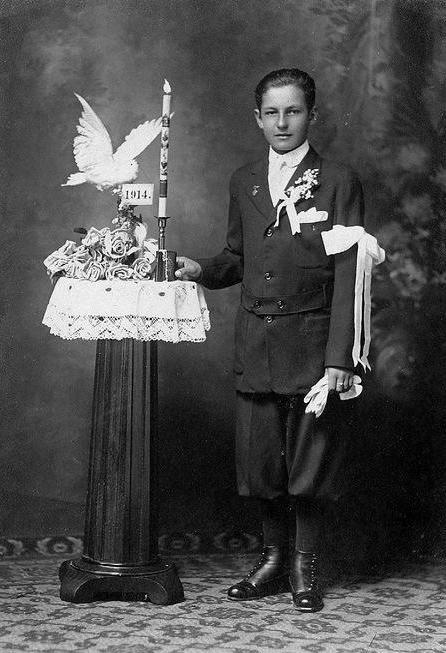
Unidentified German-American Boy: Confirmation (United States, 1914)

Figure 1.--The Christian foundation of America continues to leave a profound impact on the country. Unlike the Spanish who did not allow any but the state approved Catholic Church to be established in their colonies, the first English colonies were establisdhed by dissenting denominmations. And over time an amazing diversity of denominations developed in America. This unidentified boy who we believe to be of German ancestry is doing his Lutheran confirmation in 1914. Note the rossary and missal.
|
|
The Christian foundation of America continues to leave a profound impact on the country. Unlike the Spanish who did not allow any but the state approved Catholic Church to be established in their colonies, the first English colonies were establisdhed by dissenting denominmations. And over time an amazing diversity of denominations developed in America. Identifying Protestant denominations is difficult, except for perhaps the Lutherans. This unidentified boy who we believe to be of German ancestry is doing his Lutheran confirmation in 1914. Note the rossary and missal.
The Boy
The boy here is unidentified. He looks to be about 13 years old. He was from Milwaukee Wisconsin. We think he is of German ancestry, He looks rather German. Milwaukee and the candle also suggest German origins.
The Year
Here we do not have to guess about the year. It is clearly 1914. Of course that was a very significan year, war broke out in Europe (August 1914). We think that the confirmation was probably taken before World War I begin. The War of course began to put Germans in a bad light, especially because the Germans launched the War and reports of the German behavior in Belgian inflated by British war propaganda began to appear in the press. This blew up in 1917 when American entered the War and attacks ion German Americans occurred.
The Dove
In Roman Catholic, Anglican, Orthodox, and Lutheran churches, the Dove is the liturgical symbol of the Holy Ghost, the third person of the Trinity. There is scriptual warrant for the image It figures prominently in services of ordination (the making of priests or consecrating of bishops) and also in the sacrament of Confirmation, the service in which the bishop lays his hands on the confirmand--usually a person of about 12 or 13. Confirmation of course is the ratifying of one's baptismal vows, which in the case of infants, were taken in behalf of the child at his baptism by his sponsors (= godparents). Confirmation services are important in Lutheranism, but they figure also in the Roman Catholic annd Anglican churches. The prominance of the dove (representing the descent of the Holy Spirit) is especially appropriate for confirmation services, where the Holy Spirit is specifically invoked--usually in the ancient hymn, Veni Creator Spiritus. So the dove is not specifically Lutheran--since the third person of the Trinity is a basic belief of orthodox (trinitarian) Christianity and shared by Catholics, Anglicans, and Lutherans, as well as other Protestant denominations. The identification of the dove with peace is correct also, but, theologically, this is because it is the Holy Spirit, that is seen as the bringer of peace.
Germans in America
The dove symbol is interesting in another respect. It seems to be a particularly important symbol in Lutheranism. This seems a contrdiction as the dove is a symbol of peace and the Germans in the late 19th century and first half of the 20th century were associated with militarism. This was not the case of German Americans. In fact, opposition to military conscription along with economic freedpm (opportunity) were some of the reasons that many Germans emigrated to America. And oppositiion to American entry into World war I and II was in the heavily German-populated Midwest.
Religion
We believe th boy is Luthgeran. This is strongly suggested by his German origins. There were Catholic German immigrants, but the great bulk of German immigrahnts were Protestabts, mostly Litheran, The boy looks too old to be doing a Roman Cathlolic First Communion, but just the right age to be doing his Lutheran Confirmation. A reader rules out a Anglican ceremony, in part because of the dove. The dove is, however, a very popular symbol in Lutheranism.
Confirmation
We believe that this boy is doing his Luthern Confirmation. Boys and girls wwre usually confirmed at the age of 13 years. While Catholics focused on First Communion, Lutherans put much more enphasis on Confirmation. We note a very small rosary and missal on the tble. These were common presents for Confirmation.
Catholic Confirmatioin
A reader writes, "I think the roasry rules out Lutherans. A few very high church Lutherans might say the rosary privately, but there were almost no Lutheran churches in the United States at this time that would have used
them--at least, publicly. I used to live in Wisconsin, and there is a substantial Catholic population there. So I think this picture is pretty definitely Catholic." There were of course Catholic Germans. And my understanding is that Protestant Confirmations became so important in Germany that Catholic that some Catholic wanted them. Connfirmation is a sacramnent un the Catholic Church as well, but Catholics generally put more emphasis on First Comminion for younger children. As a result, some German Catholics and German-Americans do attxh considerable importance to Confirmation.
HBC

Navigate the Boys' Historical Clothing Web Site:
[Return to theMain U.S. confirmation page]
[Return to theMain U.S. Christian denomination page]
[Return to theMain U.S. religious faith page]
[Return to the Main U.S. religion page]
[Return to the Main religion country page]
[Introduction]
[Activities]
[Biographies]
[Chronology]
[Clothing styles]
[Countries]
[Bibliographies]
[Contributions]
[FAQs]
[Glossary]
[Images]
[Links]
[Registration]
[Tools]
[Boys' Clothing Home]
Created: 10:05 PM 1/22/2011
Last updated: 12:08 AM 1/24/2011



